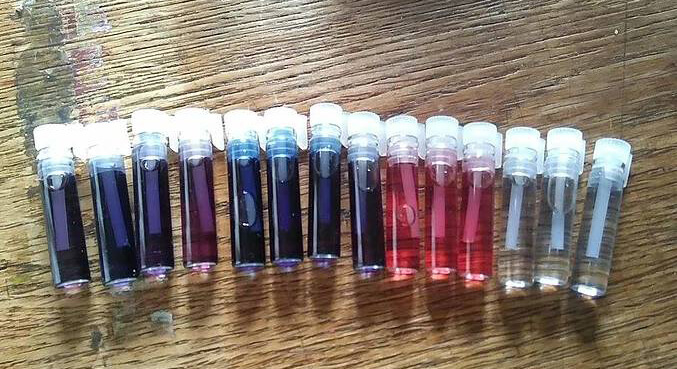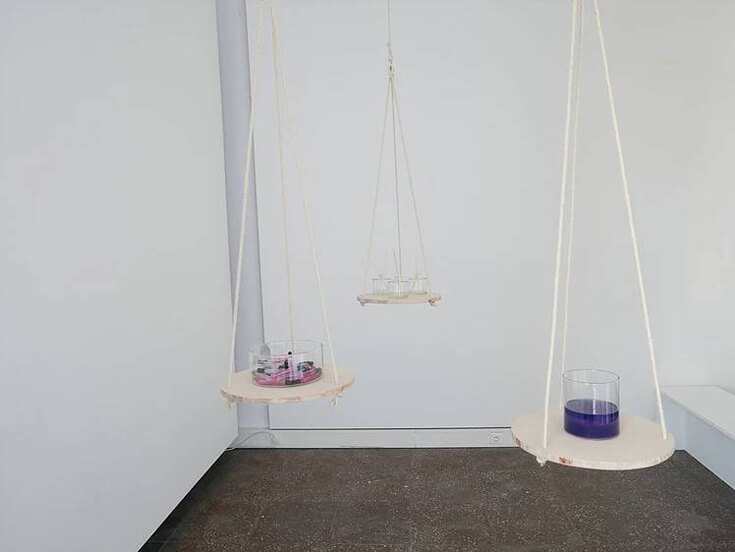Interview by Živa Brglez

Unlike other animals, humans have evolved to rely mostly on our sense of vision. Still, the sense of smell remained one of the most important ones. Olfactory chemoreception -which forms the sense of smell- has many purposes: from the detection of hazards, pheromones and food to the interaction with the parts of the brain responsible for smell identification, memory and emotion. Olfactory memory is actually one of the most persistent and resistant to the interference of all memories.
Berlin-based olfactory artist and experimental filmmaker Klara Ravat is with her work exploring that precise gap – the gap between experience and memory. With an education both in art science and psychology, she wants not only to bridge this gap but also to deny it – to oppose the strict division between the two realms itself. She views her work as conceptually deriving from the landscape since her emphasis is on creating ambient experiences for the spectator, the kind that would function as an impulse for cognition and would simultaneously work in an alienating fashion.
In one of her first projects, The Multisensory Album, she addressed the smell-memory relation in the most direct way. Since smell is one of the senses that can trigger memory most potently, why do we make photo albums – and not smell or tactile albums? She did just that. Above all, the majority of Ravat’s work can doubtlessly be characterised as participation-based and playful. A good example is last year’s Smell Transplant, where part-takers swapped odours and observed how relevant is a unique smell to a sense of identity.
Ravat co-founded Smell Lab, a community project that focuses on the investigation and practice of the art and science of the sense of smell. Smell Lab operates as a kind of platform for both olfactory art and other interdisciplinary practices that relate to scent. Within it, Ravat curated and/or participated in several events and projects, including Smell Me Smell You, a fun-loving partner-matching project where participants, through exercise, produce sweat and hence, scent.
The scents were then rated, and the algorithm made matches possible for future partners. Another example of Smell Lab production is Home Is Where The Nose Is, where together with co-workers and high school students, Ravat followed the noses in their hearts and researched the link between the sense of smell and sense of home – not the building but all the encompassing transcendental feelings and connotations that form a “home”.
Tirelessly working with and promoting scent as a medium of expression and communication and ambitiously joining several scent-researching institutions, Klara Ravat is surely one of the most innovative and original hands-on olfactory artists today.


You are an olfactory artist and an experimental filmmaker with degrees in qualitative trend research, psychology and arts. In what way has this multidisciplinary background influenced your artistic practice?
I am a very curious person in general terms, and that has led me to sniff around different areas and perspectives. As so, it has also brought me to immerse myself in different fields of study, in different depths. Multidisciplinary has brought me a wide-angle lens to my eyes and an audio-phone to my ears, and definitively it has led me to an amplification of my smelling capacities.
When going through such a different path, one is able to find the similarities in the differences, which at the end of the day, allowed me to find a personal focus or view on anything, including my artistic practice. Back at the art school, I still can remember some of my teachers suggested focusing on one medium, one concept or a topic.
At that moment, it sounded like a boring idea to me. Why would one focus on a single research one there are so many interesting topics and disciplines?! Now, I can understand the reasons why one needs to focus. It is all about time. However, I think each person has their own road to ride. I believe that one must learn how to draw boundaries in life step by step, at your own path, and I managed to figure out mine by swimming through a multiplicity of disciplines.
Year by year, I kept on discovering that no matter what discipline I was getting involved with, my main interest was relayed to people. What do they think? What do they feel? Why are some people reacting emotionally differently from others? Thanks to my multidisciplinary background I am able to look at things from different perspectives, and find a solution from a different angle. I can be quite chameleonic and be the weird fit in many different groups or contexts.
Smell is a very potent trigger of memory. Scientists have found that the memories induced by smell are more vivid or intense than those produced by other senses. Remembrance is also central to your practice. How do you artistically explore the relationship between smell and remembrance?
In fact, what makes a memory more intense it’s emotion. Research suggests that memories evoked through scent are more emotional than memories triggered by other sensory modalities. What we don’t know yet is if those memories itself are more emotional or whether the properties of odours produce a higher emotional reaction. Olfactory research is very young.
There is so much to find out! That makes it even more exciting. Anyhow, no matter if it is one way or the other, I believe that memory shapes us. Memory is who we are. Sometimes we are able to choose what to remember. Most of the time, our emotions make the selection for us. Can you imagine that? There is like a little universe in our mind that selects our memories! I wonder how much and how far we can go in choosing who we are.
In any case, what I want to say is that I believe in experience, the senses and perception. When someone has a brain injury and has a big memory loss, sometimes, depending on the damaged area, one is still able to reproduce movements and acts like playing an instrument or painting. But what is the sense of repeating a motor activity without emotion? Could someone remember who they are in the process of repetition?
And this is where remembrance jumps into my work. I want my audience to feel somehow close to my artwork. I would like them to feel like they are experiencing something refreshing and, at the same time, close to them, something that’s somewhere in the back of their minds. Have you ever come back home after being away for a longer period of time and smelled that characteristic scent of your own unique place? That is what remembrance is to me. Coming back home while being anywhere. Feeling secure while being surrounded by unknown people. Hugging your best friend.
What are the biggest challenges when developing olfactory artworks?
Rather than developing, for me, the biggest challenge comes right after developing the piece or work. You need to create very good terms of communication with the gallery or museum that’s showing your work, further than the usual one, because most of the olfactory works need to be taken care of while being on display.
You may need someone to refill your scent or to ventilate the room once in a while and make sure that the room keepers understand that “that smell” it’s part of the artwork. All these details that seem obvious are not so easygoing when you try to make the best out of your artwork. However, it’s all part of the growing olfactory art scene, and I am sure slowly, institutions and artists will learn methods on how to improve their work together.
Olfactory adaptation is triggered by a cascade of actions led by Ca2+/calmodulin-dependent protein kinase II. CaMK II desensitizes olfactory receptors to prolonged odorant exposure; How do you cope with olfactory fatigue?
Olfactory fatigue is wonderful! It forces me to stop working and go outside to breathe. Seriously, when I have been working for a few hours with a scent, I just stop, and depending on how much I can still sense, I take a long break or start fresh the next day.
Very important: my studio window is always open while I am there. I wish there would be some magic cleansing serum that would take all the scent molecules always with it. Can you imagine? Clean and fresh nose in only a few minutes!
You are the co-founder of the Smell Lab, a community project that focuses on the investigation and practice of the art and science of the sense of smell. What directions do you see taking this project into?
At the moment, we are working on making the Smell Lab grow in two directions. On the one hand, we would like to extend our educational program. We would like to offer more workshops to schools, universities, and groups of people who want to learn more about the sense of smell and olfactory art.
Also, we look forward to finding a new home, a larger space, in Berlin, to set up an Open Lab sessions event twice a month, where anybody can come over and use our scent library while they work on their own projects. Ideally, there are going to be more people working at the same time so that you can connect, share and ask for feedback from your colleagues.
On the other hand, we would love to get back on track with more creative projects, where we join forces with other institutions, organizations or agencies to create together experiences, events and installations. Last, but not least, I am working on making our community grow. The Smell Lab often collaborates with other institutions and project spaces like Mediamatic in Amsterdam or the Institute for Art and Olfaction in LA. It is very important to be in touch with other professionals in the field.
It’s beautiful to share experiences and find ways to team up. For example, we are co-producing the Experimental Scent Summit, which is an ancillary program to the Art and Olfaction Awards, every year in spring. This big meet-up aims to gather the same spot scent professionals who want to share their latest projects and have an interesting and good time together. We have also co-produced the first Scent Hackathon, and we will be having a second edition, hopefully very soon. I really love my community. I have met so many beautiful people.
Who or what was the last person, place or thing that fascinated you?
In June, I travelled for the first time to Bali with my partner. We are both great sea life passionates! Well, in one of our snorkelling sessions, I saw for the first time ever a small beautiful black moray eel. It had half of the body hidden in the rock, and the other half outside, moving with the sea vibrations. It was a powerful encounter. It looks like a dangerous creature. I was amazed by how it was floating in the water, head-shaking constantly. And the smooth black velvety skin with small white dots, it was so beautiful.
You couldn’t live without…
Passion. The beginning of any adventure.





